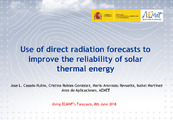Por favor, use este identificador para citar o enlazar este ítem:
http://hdl.handle.net/20.500.11765/12587
Use of direct radiation forecasts to improve the reliability of solar thermal energy
Registro completo de metadatos
| Campo DC | Valor | Lengua/Idioma |
|---|---|---|
| dc.contributor.author | Casado Rubio, José Luis | es_ES |
| dc.contributor.author | Robles González, Cristina | es_ES |
| dc.contributor.author | Revuelta, María Aránzazu | es_ES |
| dc.contributor.author | Martínez Marco, Isabel | es_ES |
| dc.date.accessioned | 2020-11-24T10:16:50Z | - |
| dc.date.available | 2020-11-24T10:16:50Z | - |
| dc.date.issued | 2018-06 | - |
| dc.identifier.citation | Using ECMWF's Forecasts (2018) | es_ES |
| dc.identifier.uri | http://hdl.handle.net/20.500.11765/12587 | - |
| dc.description | Presentación realizada en: Using ECMWF's Forecasts (UEF2018), celebrada del 5 al 8 de junio de 2018 en Reading (Inglaterra). | es_ES |
| dc.description.abstract | Concentrated Solar Power (CSP) is one of the two main techniques employed to harness the energy from the Sun. It has the distinctive advantage of being able to store energy, using it subsequently when needed (for example, at night). PreFlexMS project (www.preflexms.eu) aims to extend the flexibility of CSP to daytime, storing energy when it is sunny and dispatching it when it is cloudy. Forecasts from two meteorological models, the global IFS and the local area model Arome-Harmonie, have been used as inputs to help the CSP plant to decide the optimal schedule to follow. Both models have been verified against observations from AEMET Radiation Network to estimate their reliability, within the framework of PreFlexMS project. In this talk results will be shown (see attached figures) for the period studied, from March 2015 to February 2018. Another related project, done jointly with Red Electrica, the Spanish Transmission System Operator (TSO) will be also explained in this presentation. A combination of ECMWF radiation forecasts and Copernicus Atmosphere Monitoring Service (CAMS) aerosol forecasts has been used to improve solar power predictions for days with high aerosol content. Although aerosols don't affect scores significantly when averaged for a long period, it will be shown their huge impact in some events, and how our method can reduce the forecasting error. | es_ES |
| dc.language.iso | eng | es_ES |
| dc.publisher | Agencia Estatal de Meteorología | es_ES |
| dc.rights | Licencia CC: Reconocimiento–NoComercial–SinObraDerivada CC BY-NC-ND | es_ES |
| dc.subject | Concentrated Solar Power | es_ES |
| dc.subject | Direct Normal Irradiance | es_ES |
| dc.subject | ECMWF | es_ES |
| dc.title | Use of direct radiation forecasts to improve the reliability of solar thermal energy | es_ES |
| dc.type | info:eu-repo/semantics/conferenceObject | es_ES |
| dc.rights.accessRights | info:eu-repo/semantics/openAccess | es_ES |
| Colecciones: | Otras presentaciones-congresos | |
Ficheros en este ítem:
| Fichero | Descripción | Tamaño | Formato | ||
|---|---|---|---|---|---|
| Use_direct_radiation_... | 8,22 MB | Adobe PDF |  Visualizar/Abrir |
Los ítems de Arcimis están protegidos por una Licencia Creative Commons, salvo que se indique lo contrario.





